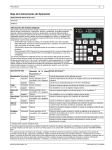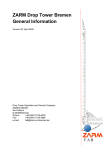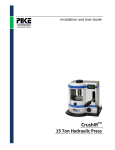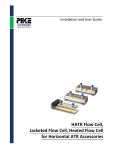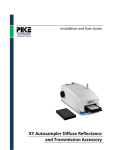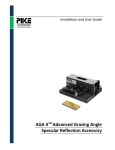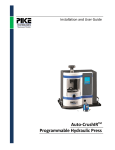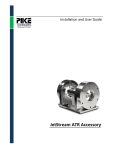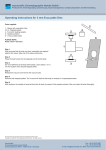Download Beam Condenser Accessory
Transcript
Installation and User Guide Beam Condenser Accessory The information in this publication is provided for reference only. All information contained in this publication is believed to be correct and complete. PIKE Technologies, Inc. shall not be liable for errors contained herein nor for incidental or consequential damages in connection with the furnishing, performance, or use of this material. All product specifications, as well as the information contained in this publication, are subject to change without notice. This publication may contain or reference information and products protected by copyrights or patents and does not convey any license under the patent rights of PIKE Technologies, Inc. nor the rights of others. PIKE Technologies, Inc. does not assume any liability arising out of any infringements of patents or other rights of third parties. This document contains confidential or proprietary information of PIKE Technologies, Inc. Neither this document nor the information herein is to be reproduced, distributed, used or disclosed, either in whole or in part, except as specifically authorized by PIKE Technologies, Inc. PIKE Technologies, Inc. makes no warranty of any kind with regard to this material including, but not limited to, the implied warranties of merchantability and fitness for a particular purpose. Copyright 1991-2015 by PIKE Technologies, Inc., Madison, WI 53719. Printed in the United States of America. All world rights reserved. No part of this publication may be stored in a retrieval system, transmitted, or reproduced in any way, including but not limited to, photocopy, photograph, magnetic or other record, without the prior written permission of PIKE Technologies, Inc. Address Comments to: PIKE Technologies, Inc. 6125 Cottonwood Drive Madison, WI 53719 Phone Fax E-mail Web Site Jan. 1, 2015 (608) 274-2721 (608) 274-0103 [email protected] www.piketech.com Contents Introduction Unpacking Your Accessory Packing List Installation Accessory Adjustment Performance Verification Sampling Procedures Precautions Mirrors Replacement Parts and Options 1 2 2 3 4 5 7 9 9 9 Introduction PIKE Technologies’ 4X and 6X Beam Condensers are a low cost, high throughput, easy-to-use transmission accessory designed for use in most major FTIR spectrometer models. Both accessories utilize highly efficient off-axis ellipsoidal mirrors providing magnification of the standard sample compartment IR beam of the FTIR system. For example, the typical 8 mm diameter sample compartment focal point is reduced to 2 mm using the 4X Beam Condenser and 1.5 mm using the 6X Beam Condenser. The compact design employs input transfer optics using two flat folding mirrors to direct the infrared beam to the ellipsoidal mirror and to the sample focus. The output transfer optics converts the beam back to the original F-number needed to properly direct the beam to the spectrometer detector. The accessory comes standard with a self-contained purge enclosure, purge tubes, hinged sample door to access the sample area, a Non-Adjustable Cell Holder Block and a 1.3 mm diameter pinhole for use in optical alignment. PIKE Technologies has developed the Beam Condenser accessory to accept a number of optional pinned-in-place sample holding devices that are optimized for applications where a small beam size is desirable. An X, Y, Z Adjustable Cell Holder Block is available for those applications where precise adjustment or sample mapping is required. There are also three optional pinned-in-place sample holders: the Universal Spring Sample Holder, Magnetic Sample Holder and the Micro KBr Pellet and Mull Holder. All three of these sample holders fit onto the alignment pins provided in the Non-Adjustable Cell Holder Block or the X, Y, Z Adjustable Cell Holder Block so that no further adjustment is needed. Figure 1. Optical diagram of Beam Condenser PN 350-031400-02 Figure 2. IR beam path of Beam Condenser P a g e |1 Unpacking Your Accessory In order for you to quickly verify receipt of your accessory, we have included a packing list. Please inspect the package carefully. Items with part numbers can be ordered separately. Contact PIKE Technologies for replacement of other items. Packing List User Manual 4X or 6X Beam Condenser Optics Purge Tube PN 350-031400 4X PN 031-40XX Quantity 8 Quantity 1 6X PN 031-60XX Quantity 1 Non-Adjustable Cell Holder Block Pinhole Alignment Fixture Purge Tubing with Connector PN 031-2020 Quantity 1 Quantity 1 Quantity 1 Hex Wrench Set Quantity 1 Set PN 350-031400-02 P a g e |2 Installation The Beam Condenser Accessory has been aligned and tested in the PIKE Technologies facility to ensure that it performs to specifications. However, some variation in optical alignment can occur from spectrometer to spectrometer. To allow for this difference, there are alignment screws provided on the base optics assembly for fine tuning once the accessory is installed in the spectrometer. The following is the procedure for accessory installation and final alignment. 1. Your Beam Condenser is configured to fit the sample compartment of the FTIR instrument you specified. Before inserting the accessory in the sample compartment, ensure that your spectrometer is aligned. If the instrument is not aligned, follow the manufacturer’s instructions for maximizing the interferogram signal (the IR energy throughput) of your FTIR spectrometer. 2. Place the accessory into the FTIR sample compartment and line up the base plate provided with the holes/pins in your FTIR Spectrometer. 3. Fasten the accessory onto the FTIR sample compartment base plate using the captive screw(s) located on the Beam Condenser base plate (some accessories may have two mounting screws or a mounting screw/pin combination, depending on spectrometer configuration). 4. Connect the blue purge tubing to the front of the accessory using the quick lock connector if purge is required. 5. The Beam Condenser accessory is now ready for optical alignment. PN 350-031400-02 P a g e |3 Accessory Adjustment The Beam Condenser accessory may not require any alignment when installed. However, should you choose to fine tune the accessory, follow these steps: 1. Install the pinhole alignment fixture in the accessory (Figure 4). The flat side of the alignment fixture is positioned facing toward the input beam side of the spectrometer, while the recess side faces the detector side. If you are not familiar with the beam direction of your spectrometer, call the spectrometer manufacturer. Figure 3. Assembly of the pinhole alignment fixture. Figure 4. Placement of the pinhole alignment fixture inside the accessory. 2. There are four alignment screws that may be used for adjustment of the optical alignment in the Beam Condenser. To access the adjusting screws, remove the rear purge cover plate by unscrewing the four mounting screws (Figure 5). Figure 5. Mounting screws on purge cover plate. PN 350-031400-02 P a g e |4 3. Display the live interferogram on the spectrometer monitor and adjust the input mirror screws until maximum signal is obtained (Figure 6). The location of this mirror may be found on the back left or right side depending on the spectrometer brand. Contact your spectrometer manufacturer if you are unsure about the beam direction of your spectrometer. To adjust, turn the screws one at a time slightly and check the signal. If it decreases, reverse the turn until the maximum signal is obtained. Figure 6. Overhead view of input and output mirror adjustment screws. 4. Next, adjust the output mirror screws until maximum signal is obtained (Figure 6). The location of this mirror may be found on the back left or right side of the accessory depending on the spectrometer brand. To adjust, turn the screws one at a time slightly and check the signal. If it decreases, reverse the turn until the maximum signal is obtained. 5. Repeat the entire procedure two or three times to fine tune the accessory. 6. Replace the rear purge cover plates. You are now ready to verify the Beam Condenser optical throughput performance. Performance Verification 1. With the accessory removed from the sample compartment, collect an open-beam background spectrum. 2. Place the Beam Condenser accessory in the instrument per installation steps described on page 3. Do not use a sample holder or pinhole alignment fixture inside the accessory during this part of the performance verification process. 3. Collect a spectrum of the Beam Condenser using the same collection parameters as used to collect the background spectrum. 4. The % transmission at 2000 cm-1 for the 4X Beam Condenser should be greater than 40%, and 6X Beam Condenser should be greater than 30% (Figure 7). PN 350-031400-02 P a g e |5 5. The next step is to confirm alignment. Place the pinhole alignment fixture inside the Beam Condenser. Collect a spectrum using the same collection parameters used for the background spectrum. Ratio the sample spectrum against the background spectrum collected in step 1. 6. Through the pinhole alignment fixture, the % transmission at 2000 cm-1 for the 4X Beam Condenser should be greater than 28%, and the 6X Beam Condenser should be greater than 18% (Figure 8). If your accessory does not meet this minimum transmission level, we recommend realigning the instrument. If the accessory still does not meet minimum performance standards, please contact PIKE Technologies. Before calling, please record the serial number located on the label on the back of the base optics assembly. Figure 7. Energy throughput for the 4X Beam Condenser without pinhole alignment fixture. Figure 8. Energy throughput for the 4X Beam Condenser with pinhole alignment fixture. PN 350-031400-02 P a g e |6 Sampling Procedures Samples need to be held in the focused beam in the Beam Condenser. The beam through the Beam Condenser is much smaller than in the main sample compartment, thus the sample alignment is more critical. For extended samples, when you wish to obtain the spectrum of a small portion of the sample, make sure the sample is positioned at the focal point of the accessory. The Non-Adjustable Cell Holder Block (standard) fits between the focusing mirrors and the two pins in the baseplate assure that the block can be precisely repositioned consistently. Two small pins located on the top of the block provide a standard repositioning means for all the sample holders. Several sample holders are available: the Universal Spring Sample Holder, the Micro KBr Pellet and Mull Holder, the Magnetic Sample Holder, and the X, Y, Z Adjustable Cell Holder Block. To use place the holder on the pins of the cell holder block and you are ready to run the measurement. The two small pins are symmetrical, so all the sample holders can be mounted two ways. The Beam Condenser accessory is factory aligned to maximum throughput for the sample holders positioned such that the sample is to the right of the pins if we are facing the accessory from the front (see picture). In the other direction the position of the sample will not be in the focus of the beam, thus the signal will be much smaller. Universal Spring Sample Holder Micro KBr Pellet and Mull Holder and Apertures Magnetic Sample Holder The Universal Spring Sample Holder (optional) is designed to hold small objects with different diameters. Press together the two arms of the holder and position the sample in between the jaws of the holder. Make sure that the edges of the sample are held firmly by the slots machined in the face of the jaws. A typical sample, such as infrared transmitting jewel stone, is now positioned at the center of the aperture on the holder. For samples that can be spread onto a 13 mm diameter infrared transmitting window, the Micro KBr Pellet and Mull Holder (optional) should be used. The inside diameter of the ring holding the pellet is approximately 13 mm. The rings are designed to hold a 13 mm diameter window when measuring pastes or other viscous liquids. An inexpensive disposable window can also be made from KBr Powder PN 350-031400-02 P a g e |7 using a PIKE Evacuable Pellet Press for 13 mm pellets in combination with a PIKE CrushIR Hydraulic Press. These windows can fit directly into the Micro KBr Pellet and Mull Holder. For KBr pellet measurements, such as KBr micro pellets, place the Micro KBr Pellet and Mull Holder on the two dowel pins of the Non-Adjustable Cell Holder Block. Slide the disposable KBr pellet into the slot of the circular ring. Thin samples can move in the holder. In order to prevent the sample from moving, a paper ring or similar simple means should be used to hold the micro pellet parallel to the sample holder. Mount the window and lightly tighten the mounting screws of the ring to secure the window. Different diameter apertures are also provided to be used with the Micro KBr Pellet and Mull Holder or with the Magnetic Sample Holder. Apertures are useful when you wish to limit the measuring window to a certain portion of the sample, making sure that the resulting spectrum does not come from other parts of the sample. The aperture can be placed inside the pellet holder or held by the magnet of the Magnetic Sample Holder. Films and plastics should be measured using the Magnetic Sample Holder (optional). The film should be stretched in front of the measuring window and held by the magnet supplied with the holder. The body of the holder is made of steel, thus the magnetic force will hold thin samples in place during the measurement. A Micro-Diamond Transmission Cell is ideal for easily holding and flattening small samples, and is best used with a 4X or 6X Beam Condenser due to the aperture size (generally 2 mm or less). It is recommended when using this Micro-Diamond Cell to align the accessory as described in the manual to verify performance. Then, insert the Micro-Diamond Cell into the cell holder and maximize the energy in the software’s monitor mode by adjusting the input mirror prior to use. The input mirror may be located in the left rear or right rear of the accessory depending on the direction of the spectrometer beam path as explained on page 5 (Figure 6). The X, Y, Z Adjustable Cell Holder Block (optional) allows the same sampling with the additional capability of being able to either adjust the sample for maximum signal or to provide a manual scanning capability. On the X, Y, Z mounting arm the two small pins provide the standard repositioning means for all the sample holders. Figure 9. The X, Y, Z, Adjustable Cell Holder Block. PN 350-031400-02 P a g e |8 Precautions Mirrors In order to provide the maximum transmission in the infrared, with minimum spectral interferences, the mirrors used in this device are uncoated (bare) aluminum on a glass substrate. Since the coatings are soft, care must be taken to avoid damage. Normally, these mirrors will not need cleaning since they are contained within the housing of the accessory. If they do need cleaning, they may be gently wiped with a lint-free, abrasive-free cloth, such as lens tissue, or with a camel hair brush. Under no circumstances must the mirrors be rubbed with paper products such as "Kleenex" since this will produce scratching of the mirror coating. Replacement Parts and Options The following maintenance parts are available: Part Number Description 031-2010 031-2020 031-2030 031-2040 031-2050 162-0010 162-0020 031-2070 181-1100 161-1900 X, Y, Z Adjustable Cell Holder Block Non-Adjustable Cell Holder Block Universal Spring Sample Holder Magnetic Sample Holder Micro KBr Pellet and Mull Holder Micro Diamond Cell, 1.6 mm Micro Diamond Cell, 2.0 mm Holder for Micro Diamond Cell PIKE CrushIR Hydraulic Press Evacuable Pellet Press for 13 mm pellets PN 350-031400-02 P a g e |9 6125 Cottonwood Drive · Madison, WI 53719-5120 · (608) 274-2721 (TEL) · (608) 274-0103 (FAX) [email protected] · www.piketech.com













